To create perfumes at home like a pro, you'll need seven essential tools: a digital scale for precise measurements, borosilicate glass beakers for mixing, pipettes for accurate transfers, dark glass bottles for storage, protective gear (gloves and goggles), testing strips for scent evaluation, and a notebook for formula tracking. These fundamental tools will help you blend fragrances safely and accurately. Learn how each tool can transform your perfume-making journey from amateur to expert.
Essential Measuring Tools for Perfect Perfume Ratios
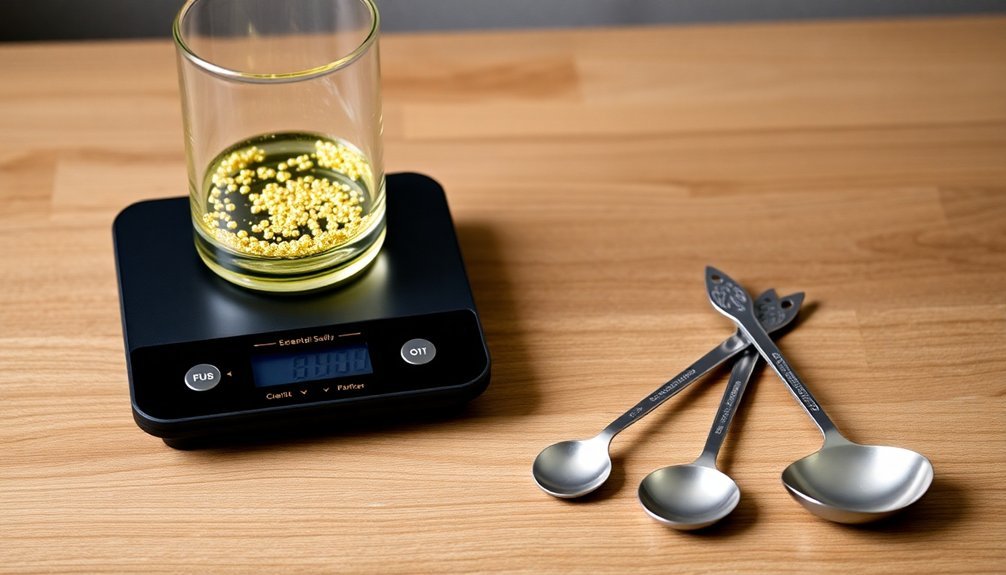
Four essential measuring tools form the foundation of successful perfume making at home.
You'll need a digital scale that measures to the hundredths (0.00) and handles up to 200 grams for precise ingredient measurements. Glass measuring cylinders and columns, available from laboratory supply houses, provide superior accuracy compared to plastic alternatives when adding small amounts of ingredients. Borosilicate beakers are particularly useful for dilution measurements and mixing small batches.
For handling tiny quantities of essential oils and fragrances, you'll want droppers and pipettes, particularly Monprene droppers for diluting aromatics. When working with thick substances like labdanum, pair these with wax-carving tools.
Finally, thermometers and conductivity meters guarantee you're mixing ingredients at the right temperature and can monitor the saturation of alcohol tinctures. These tools enable you to create consistent, accurately measured perfumes every time.
Glass Containers and Mixing Equipment
You'll need high-quality beakers for accurate measurements of your fragrance ingredients, ensuring precise ratios every time you blend.
When selecting storage vessels, opt for dark glass bottles that protect your perfumes from light damage while maintaining the scent's integrity through their non-reactive properties. Choose containers ranging from 8ml to 100ml to accommodate different batch sizes and testing needs.
Your mixing toolkit should include glass stirring rods, droppers, and small funnels to help you combine ingredients efficiently and minimize waste during transfers.
Beakers For Precise Measurements
Precise measurements stand at the heart of successful perfume making, and quality glass beakers are essential tools for this delicate work.
Consider rinsing with ethanol after each transfer to minimize material loss and ensure full recovery of expensive ingredients.
You'll want to invest in low-actinic borosilicate glass beakers with clear volume markings for accuracy and protection against light degradation.
Before using your beakers, clean them thoroughly with soapy water and sterilize with ethanol.
You'll need various sizes to handle different quantities of raw materials. For the most accurate results, measure each ingredient separately in its own beaker, using digital scales for weight-based measurements.
When you're ready to blend, transfer your materials to a larger beaker and use a PTFE or glass stir bar for thorough mixing.
Don't forget to filter your final creation for clarity and store your clean beakers in a dry place between uses.
Choosing Quality Storage Vessels
After mastering precise measurements, selecting proper storage vessels becomes the next key step in your perfume-making journey. Glass containers are essential for both mixing and storing your perfumes, as they won't react with essential oils or alcohol content like plastic or metal alternatives would.
When choosing your storage vessels, prioritize these key features:
- Dark or amber glass bottles to protect against light degradation
- Airtight stoppers or screw caps to prevent contamination
- Non-reactive glass mixing bowls for blending ingredients
- Easy-to-clean surfaces for proper sterilization
You'll find that glass vessels maintain your perfume's integrity while offering practical benefits. They're easy to sterilize, don't retain odors, and allow you to monitor the mixing process clearly.
Plus, they're completely recyclable, making them an environmentally conscious choice for your perfume-making endeavors.
Essential Mixing Tools
While quality ingredients form the foundation of perfume-making, reliable mixing tools transform those raw materials into sophisticated fragrances.
You'll need borosilicate beakers for dilutions, graduated cylinders for precise measurements, and glass funnels equipped with filter papers to remove unwanted particles.
A high-quality electric mixer is essential for blending oils of different consistencies. Run it in short bursts, pausing every 12 hours to check your perfume's development.
Don't forget to include a Teflon bar mixer to assist with the aging process. For proper oil separation, you'll require a separatory funnel mounted on a metal stand.
Keep a stainless steel tray underneath your work area to protect surfaces during pouring and mixing operations. Remember that even though fragrances aren't highly viscous, your mixer should have sufficient torque for thorough blending.
Precision Transfer Tools and Pipettes
You'll find pipettes essential for controlling exact amounts of fragrance oils in your perfume-making journey.
Whether you choose disposable plastic pipettes for convenience or glass versions for their durability with solvents, these precision tools guarantee clean transfers without cross-contamination between different scents.
Your success in crafting perfumes depends on mastering transfer techniques, from handling thin essential oils to working with thicker bases like sandalwood.
Precise Liquid Control
When creating perfumes at home, precise liquid control is essential for achieving consistent, professional-quality results.
You'll need reliable pipettes to transfer small amounts of fragrance oils and other liquid ingredients accurately. Disposable pipettes are particularly valuable as they prevent cross-contamination between different scents and can be heat-sealed for sample storage.
For precise measurements, you'll want to have:
- Graduated pipettes marked with specific volume measurements
- Various sizes of disposable pipettes (3ml and 5ml capacities)
- Digital scales for accurate ingredient weighing
- Glass measuring cylinders for larger liquid quantities
These tools allow you to maintain exact proportions in your formulas, ensuring your perfumes turn out the same way every time.
Remember to sterilize your reusable equipment before each use to maintain the purity of your fragrances.
Glass Vs Plastic Options
Now that you've gathered your precision tools, choosing between glass and plastic equipment can greatly impact your perfume-making success. While glass offers superior durability and chemical stability, plastic provides convenience and affordability. Let's compare your options:
| Feature | Glass | Plastic |
|---|---|---|
| Durability | Long-lasting, reusable | Limited lifespan |
| Chemical Stability | Non-reactive, preserves scent | May react with fragrances |
| Maintenance | Requires cleaning | Disposable |
| Cost | Higher initial investment | Lower upfront cost |
| Environmental Impact | 100% recyclable | Creates more waste |
For serious perfumery, you'll want to invest in glass tools. They'll maintain your fragrances' integrity and provide precise measurements consistently. However, if you're just starting out or need backup options, plastic tools can serve as practical alternatives for initial experiments and learning the basics.
Clean Transfer Techniques
Three essential transfer techniques stand at the heart of successful perfume-making: syringes, funnels, and pipettes.
You'll need syringes and droppers for bottles with non-removable nozzles, while small funnels work best when you can remove the spray top. For travel bottles, direct sprayer transfers offer the quickest solution.
When working with precise measurements, you'll want to use either disposable plastic pipettes or micropipettes.
To maintain the purity of your fragrances:
- Clean all tools with alcohol wipes before and after use
- Sterilize glass equipment with ethanol
- Never reuse pipettes between different scents
- Leave space in bottles to prevent pressure buildup
Remember to clean your transfer tools thoroughly between uses to avoid cross-contamination and maintain the integrity of your fragrances.
Safe Storage Solutions for Your Fragrances
Proper storage is the cornerstone of maintaining your homemade perfumes' quality and longevity.
You'll want to keep your creations in a cool, dark environment between 15-20°C (59-68°F), with humidity levels at 50% or below. Your bedroom closet or a dark cupboard makes an ideal spot, while bathrooms and windowsills are definite no-gos.
Protect your fragrances by storing them in their original boxes or investing in specialized perfume storage containers with UV protection.
For extra safeguarding, double-pack precious blends in airtight bags. Don't forget to seal bottles tightly after each use to prevent oxidation, and consider adding silica gel packs to your storage area to control moisture.
Keep your perfumes on low shelves to avoid accidents, and they'll stay fresh and vibrant for much longer.
Personal Protection Gear for Safe Blending
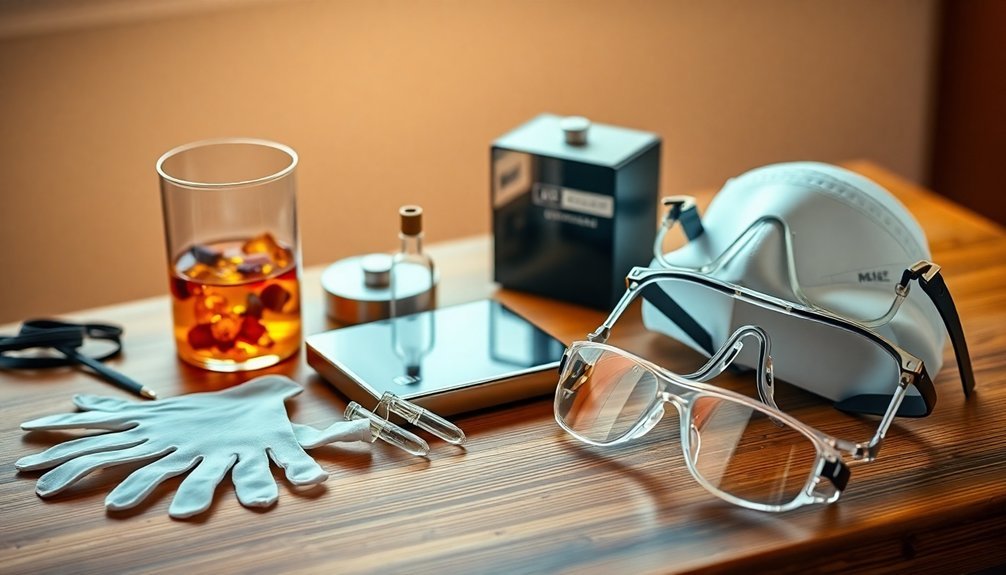
While storing your perfumes safely protects your creations, protecting yourself during the blending process is equally important.
You'll need essential protective gear to handle fragrance materials safely and prevent any accidents or exposure to harmful substances.
For a safe perfume-making experience, you'll need:
- Safety goggles and a face shield to protect against splashes
- Chemical-resistant gloves to prevent skin contact with raw materials
- A protective apron or lab coat to shield your clothing
- A properly fitted mask to avoid inhaling strong fumes
Remember to work in a well-ventilated area and keep your hair tied back.
Remove any jewelry before starting, and always wear closed-toe shoes.
Keep a first aid kit nearby, and guarantee all your emergency contact information is easily accessible in your workspace.
Quality Testing Equipment for Scent Development
Creating exceptional perfumes requires precise testing equipment to guarantee quality and consistency in your fragrance development.
You'll need basic analytical tools like a precision balance for accurate measurements and testing strips to evaluate scents without skin chemistry interference. A set of clean pipettes and glass measuring cylinders will help you transfer and mix ingredients precisely.
Don't forget essential environmental controls – a reliable thermometer to monitor temperature conditions and proper storage containers to maintain fragrance integrity.
For advanced testing, you might want to invest in a small spectrophotometer to check color properties and stability.
Remember to keep your equipment clean with sterilization tools and soapy water. If you're serious about perfume making, consider digital scales for precise weighing and professional testing strips for consistent scent evaluation.
Basic Record-Keeping and Documentation Tools
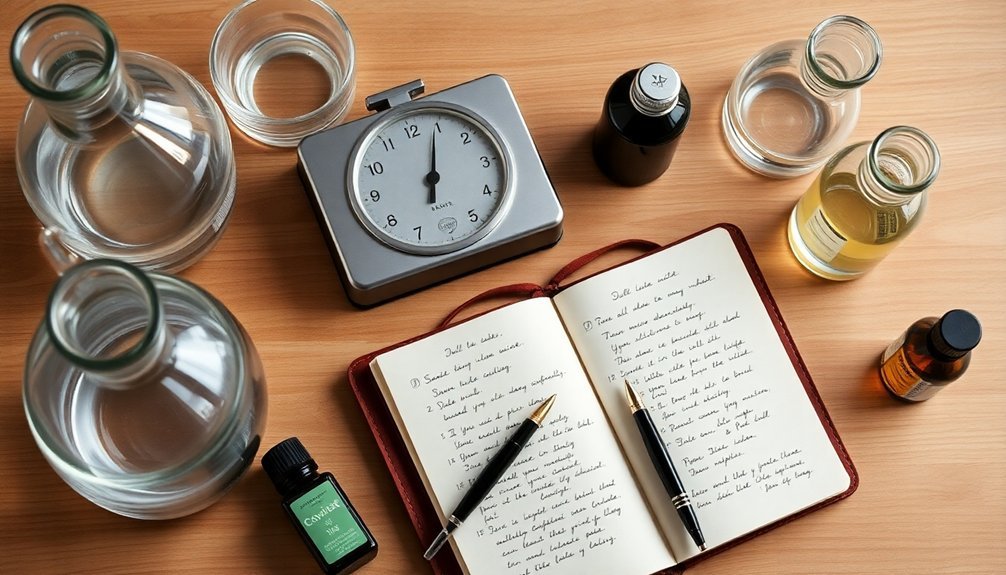
To develop professional-quality perfumes, you'll need robust documentation tools for tracking your formulations and experiments. A reliable system helps you maintain detailed records of your raw materials, formulas, and testing results while guaranteeing consistency in your creations.
Keep track of essential information with these fundamental tools:
- Digital spreadsheet for recording raw material details, including costs, suppliers, and IFRA limits.
- Formula writing software that can scale recipes and calculate percentages automatically.
- Notebook or digital system for documenting scent pyramids and evaporation stages.
- Database tool for organizing supplier information and tracking inventory expiration dates.
Your documentation system should sync across devices and allow for easy data export to different formats. This guarantees you'll always have access to your perfume-making records, whether you're in your workshop or on the go.
Frequently Asked Questions
How Long Does Homemade Perfume Typically Last Before Expiring?
Your homemade perfume will typically last 6-12 months if you've used proper storage conditions. If you've included alcohol and stored it in a dark, cool place, it can last up to 18 months.
Can I Reuse Equipment That's Been Used With Different Fragrances?
Yes, you can reuse equipment, but you'll need to clean it thoroughly with isopropyl alcohol to prevent cross-contamination. Glass items are easiest to clean, while plastic atomizers may retain residual scents.
What's the Best Room Temperature for Perfume Making?
You'll want to maintain a room temperature between 60-70°F (15-21°C) when making perfumes. Keep your workspace at a consistent temperature to prevent oil degradation and maintain the fragrance's integrity during creation.
How Do I Properly Clean and Sterilize My Perfume-Making Equipment?
You'll need to clean your equipment with soapy water first, then use rubbing alcohol to remove stubborn scents. Don't forget to rinse thoroughly and sterilize with alcohol or UV light before your next use.
Where Can I Source Professional-Grade Perfume-Making Equipment?
You'll find professional perfume equipment through PerfumersWorld, Amazon, and USSolid. For high-grade supplies, check Anya's Garden for beakers and tools, or explore industrial suppliers like Groninger for specialized machinery.
In Summary
You'll find that investing in these seven essential perfume-making tools transforms your hobby into a professional craft. With proper measuring equipment, storage solutions, and safety gear at your fingertips, you're ready to create unique fragrances from home. Keep detailed records of your experiments, maintain high-quality testing standards, and guarantee you're using the right tools – your perfume-making journey starts with this foundation.


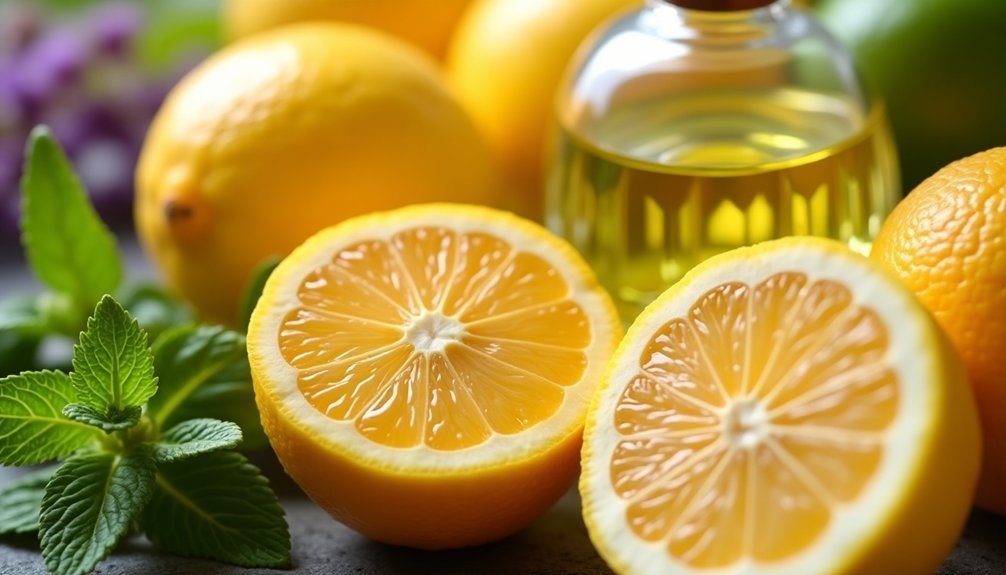
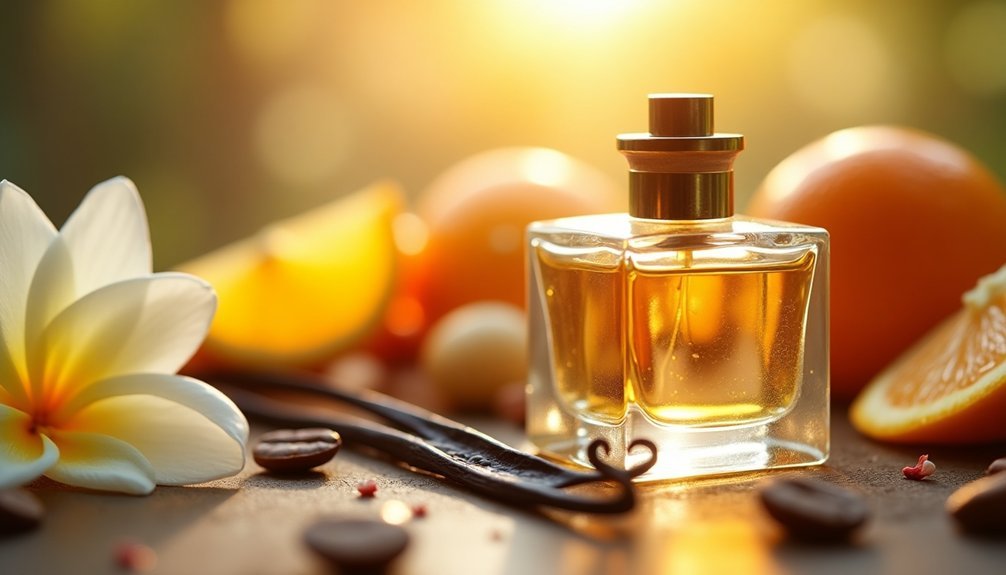

Leave a Reply